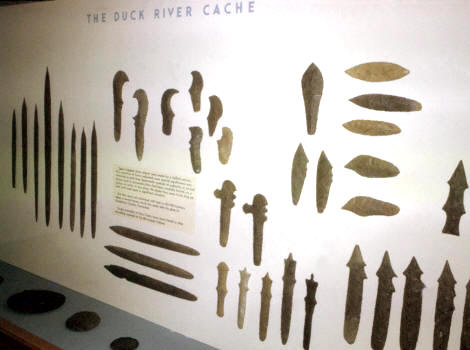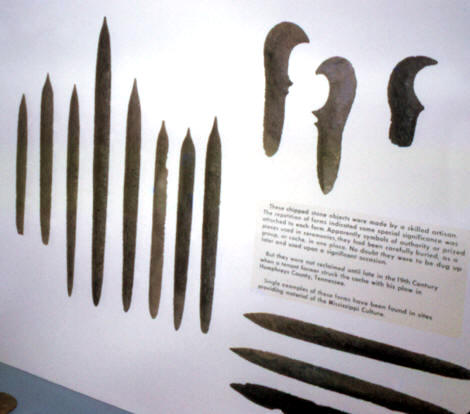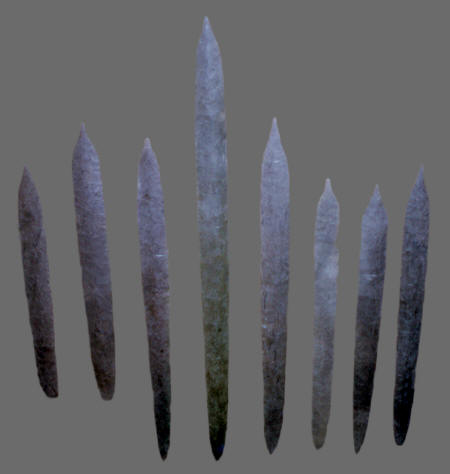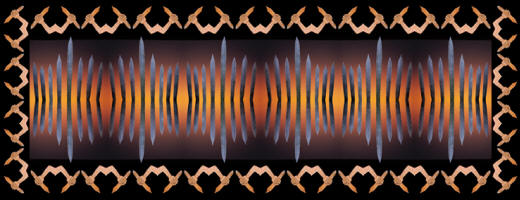|
"In the late
1880's, an archaeological discovery was made in Humphreys County,
Tennessee which was said at that time to be the greatest single
archaeological find ever made in the United States. This
discovery,----was later to become known as the "Duck River Cache----."---1981,
H. C. Brehm, "The History Of The Duck River Cache,"
Miscellaneous Paper No. 6, Tennessee Anthropological Association, p. 1.
"The oval, double-pointed "flints," (swords)
are, as far as known, the finest examples of flint chipping that have
been discovered in North America and, possibly in the world."---1897,
William J. Seever, The Antiquarian, "A Cache Of Idols And
Chipped Flint Instruments In Tennessee," p. 145.
"The remarkable
length of the objects (Duck River
Cache "Swords") would at once suggest
coarseness, but the chipping is as remarkable as the extreme length of
the objects---."----1897, William J.
Seever, The Antiquarian, "A Cache Of Idols And Chipped Flint
Instruments In Tennessee," p. 145.
"In December, 1894, an employee of Mr. Links, while
plowing in this field (on the Links
farm), turned up several implements.
Their form and size being unusual, time was taken to dig, and the
objects (Duck River Cache)----were
found"---1897, William J. Seever, The Antiquarian, "A
Cache Of Idols And Chipped Flint Instruments In Tennessee," p. 141.
"A remarkable and unexplainable feature of the find is, that with
the exception of the long, slender, double-pointed specimens, all the
forms, with one exception, are in pairs of two of each form."---1897,
William J. Seever, The Antiquarian, "A Cache Of Idols And
Chipped Flint Instruments In Tennessee," p. 142.

DUCK RIVER CACHE
MISSISSIPPIAN PERIOD
HUMPHREYS COUNTY, TENNESSEE
Caches of Stone Age artifacts, from all cultural time periods, have been
found in North America. They are most often found by the public on land
that's been disturbed by farming or construction or by soil erosion. The
most reliable information about caches can be found in published reports
that describe archaeological excavations. Most of the caches that
contain flaked stone artifacts are represented by simple and small tools
that relate to utilitarian purposes. They may contain raw materials in
the form of flakes or preforms or tools that could be used for
hunting
or processing food. But the Duck River Cache represents a smaller
percentage of caches that apparently contain objects that relate to
ritual applications.
|
|

CLICK ON
PICTURE FOR LARGER IMAGE
DUCK RIVER CACHE
(McCLUNG MUSEUM DISPLAY)
MISSISSIPPIAN PERIOD
HUMPHREYS COUNTY, TENNESSEE
FRANK H. McCLUNG MUSEUM
COLLECTIONS
(THE UNIVERSITY OF TENNESSEE)
This picture shows the Duck River Cache on display at the Frank H.
McClung museum at Knoxville, Tennessee. The cache was discovered in
1894 by an employee on a farm in western Tennessee. The cache
contains 46 bifaces that were flaked into many different "exotic"
forms that have been interpreted as "ceremonial objects." The cache
was discovered on a farm owned by Mr. Banks Links. They were found
on land that is described as "having been in cultivation for many
years, wagon-loads of flat rocks used in building the graves have
been carted off and the human remains scattered." It's interesting
to note that there is no specific mention of any human remains found
directly with the Duck River Cache. It's also reported that "Other
"swords" and maces were found in caches during the 1936
archaeological explorations of the Link site mounds and habitations.
One house-mound is reported to have yielded "four sword preforms." |
|
|
The Duck River Cache is one of the most famous flaked stone
artifact caches
ever found in North America. In fact, at the time of the discovery it
was said, "to be the greatest single archaeological find ever made in
the United States." The number of artifacts, the variety of exotic
shapes, the quality of craftsmanship and their extreme size sets it
apart from other caches. |
|

DUCK RIVER CACHE
(McCLUNG MUSEUM DISPLAY)
MISSISSIPPIAN PERIOD
HUMPHREYS COUNTY, TENNESSEE
FRANK H. McCLUNG MUSEUM
COLLECTIONS
(THE UNIVERSITY OF TENNESSEE)
The Duck River Cache is most extraordinary for the size of the
cache, the variety of
exotic shapes, the level of skill required to make them and their
extreme size. These impressive qualities sets it apart from other
caches. This picture shows the eleven "swords" in the cache and
three of the four "eagle claw" effigies. |
|
|
The Duck River Cache was discovered in 1894 by either a black
gentleman named Cave Nolan or by George Pewett. At the time of the
discovery they were working as laborers on the Link farm in Humphreys
County, Tennessee. The find was apparently made while cultivating a
field. It was reported that, "the cache of 46 flint artifacts were
enough pieces to fill a bushel basket." In 1895, the collection was
purchased from W. H. Meadow and R. W. Childs by the Missouri Historical
Society for $250. and displayed in St. Louis, Missouri for several years
in the Jefferson Memorial Museum. Approximately fifty years later the
Duck River Cache was returned to Tennessee where it's currently on
exhibit in the Frank H. McClung Museum at the University of Tennessee at
Knoxville. |
|

DUCK RIVER CACHE
MISSISSIPPIAN PERIOD
HUMPHREYS COUNTY, TENNESSEE
FRANK H. McCLUNG MUSEUM
COLLECTIONS
(THE UNIVERSITY OF TENNESSEE)
Of all the biface forms in the Duck River Cache the most impressive
are the "swords." The eight examples illustrated here represent the
work of a highly skilled flintknapper. Especially when you consider
the fact that they were made from nodular Dover chert. Most of the
large spades, hoes, and Ramey knives, that were produced from quarry
sites in southern Illinois, were made from tabular Mill Creek chert.
The natural structure of the raw material makes it far more
difficult to produce a Dover "sword" from thick nodules compared to
a Mississippian "sword" that was produced from flat tabular chert.
The longest "sword" in the Duck River cache measures 28 inches (71.1
cm) long. Some of the lengths of the other "swords" are 14 3/4 (37.5
cm), 17 1/2 (44.5 cm), 18 1/4 (46.3 cm), 18 1/4 (46.3 cm), 18 1/2
(47 cm), 19 (48.2 cm), 19 (48.2 cm), 21 3/4 (55.2 cm) and 22 (55.9
cm) inches long. |
|
|
The Duck River Cache contains many very large "eccentric" bifaces.
The longest example, a "sword," measures 28 inches (71.1 cm) long. There
are only two locations in North America where bifaces have reach this
extreme size. Their large size is directly related to the available raw
material in these areas. The largest bifaces in North America were
made in
California from Obsidian. Most of the Duck River Cache bifaces are made
from Dover chert, only a small number of them were made of Fort Payne
chert. Although Dover chert outcrops in southern Illinois, western
Kentucky and the Highland rim of Tennessee, the large quarry-workshops
are located near Dover in Stewart County, Tennessee. In 1973, the Dover
quarries were listed in the National Register of Historic Places. |
|
CONTINUE ON TO PAGE
TWO
|
|
"REFERENCES"
1897, Sever, William
J., The Antiquarian, "A
Cache Of Idols And Chipped Flint Instruments In Tennessee," pp.
141-145.
1897, Rust, Horatio
N., The Antiquarian, "Survivals
Of The Stone Age, And Evolution Of Certain Stone Implements," pp.
284-287.
1972, Compton, Carl B.,
Ten Years Of The Tennessee Archaeologist Selected Subjects, Vol. II, "
Duck River And Similar Artifacts," pp. 196-201.
1972, Kneberg, Madeline, Ten Years Of The Tennessee
Archaeologist Selected Subjects, Vol. II, " Engraved Shell
Gorgets And Their Associations," pp. 231-269.
1981, Brehm, H. C., "The
History Of The Duck River Cache," Miscellaneous Paper No. 6,
Tennessee Anthropological Association, pp. 1-24.
1992, Gramly, Richard Michael, Prehistoric Lithic Industry At
Dover, Tennessee, pp. 1 & 2.
2003, McClung Museum Website,
"Archaeology And The Native Peoples Of Tennessee."
1980's,
Personal communications with Larry Conrad.
The Tennessee Encyclopedia Of History And Culture, web site
|
|
RECENT
LISTINGS HOME
ORDERING |





